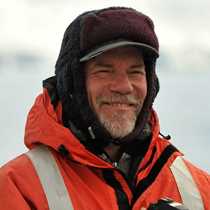At Sea
The Falkland Islands now lie in our wake and behind them South Georgia, the South Orkneys, the South Shetlands and the Antarctic Peninsula. Over the past three weeks we have cruised a great anti-clockwise curve around the Scotia Arc, landing on volcanic islands, granite beaches and metamorphic mountains, sailing polar seas among miles-long icebergs and meeting penguins and peregrines, seals, seabirds, and sea slugs, whales and dolphins and fellow travelers.
Along our route we have observed something of the deeper nature of the Antarctic in the contrasts evolving around our vessel as we circled through this frozen world. Isolated at the austral pole, this is a unique region, separate for millions of years, harsh and unforgiving, spectacular, alluring.
Along the mountainous shores of the Peninsula and cruising the icy Weddell Sea we encountered scenes and creatures that are purely Antarctic. Crabeater seals, Adelie Penguins, giant isopods and many other species are endemic to the Antarctic, found nowhere else in the world. So too are the vistas we found on these wild shores. No trees, no land animals, virtually no plants, this is a place of rock and ice, decorated by brilliant lichens and glowing green mosses.
Then, at South Georgia, we stood on the edge of the Antarctic. Here we saw the polar world softened slightly. Just below the convergence, this astounding island shares many features with her colder neighbors to the south, but tussock grass and pipits flourish here as well. Standing in a katabatic wind from the glacier, we watched albatross settle onto their ancient nesting grounds.
And now we are in temperate seas once more. In the windswept Falkland Islands we still met penguins and albatross, but the winds were warmer and the seas showed us flourishing kelp forests, alive with crabs and fish not found in the freezing waters of the Southern Ocean. Hail fell from scudding clouds but a welcoming tea in a farm house showed us that we had returned to more mild climates and outposts of civilization that do not reach into the Antarctic.
Three weeks looping through the Antarctic has given us the time to see it clearly, to breathe it in deeply and watch it change around us. And one other facet of this unknown southern land has also become very clear: its nature has changed ours. We are all just a little transformed by where we have been and what we have seen. We all hold the Antarctic in our hearts.
The Falkland Islands now lie in our wake and behind them South Georgia, the South Orkneys, the South Shetlands and the Antarctic Peninsula. Over the past three weeks we have cruised a great anti-clockwise curve around the Scotia Arc, landing on volcanic islands, granite beaches and metamorphic mountains, sailing polar seas among miles-long icebergs and meeting penguins and peregrines, seals, seabirds, and sea slugs, whales and dolphins and fellow travelers.
Along our route we have observed something of the deeper nature of the Antarctic in the contrasts evolving around our vessel as we circled through this frozen world. Isolated at the austral pole, this is a unique region, separate for millions of years, harsh and unforgiving, spectacular, alluring.
Along the mountainous shores of the Peninsula and cruising the icy Weddell Sea we encountered scenes and creatures that are purely Antarctic. Crabeater seals, Adelie Penguins, giant isopods and many other species are endemic to the Antarctic, found nowhere else in the world. So too are the vistas we found on these wild shores. No trees, no land animals, virtually no plants, this is a place of rock and ice, decorated by brilliant lichens and glowing green mosses.
Then, at South Georgia, we stood on the edge of the Antarctic. Here we saw the polar world softened slightly. Just below the convergence, this astounding island shares many features with her colder neighbors to the south, but tussock grass and pipits flourish here as well. Standing in a katabatic wind from the glacier, we watched albatross settle onto their ancient nesting grounds.
And now we are in temperate seas once more. In the windswept Falkland Islands we still met penguins and albatross, but the winds were warmer and the seas showed us flourishing kelp forests, alive with crabs and fish not found in the freezing waters of the Southern Ocean. Hail fell from scudding clouds but a welcoming tea in a farm house showed us that we had returned to more mild climates and outposts of civilization that do not reach into the Antarctic.
Three weeks looping through the Antarctic has given us the time to see it clearly, to breathe it in deeply and watch it change around us. And one other facet of this unknown southern land has also become very clear: its nature has changed ours. We are all just a little transformed by where we have been and what we have seen. We all hold the Antarctic in our hearts.




